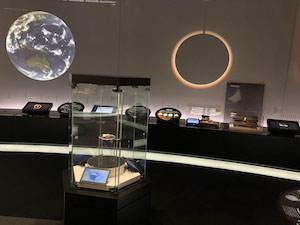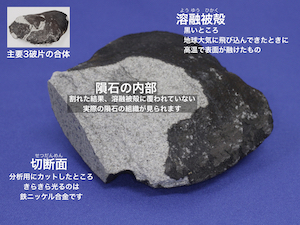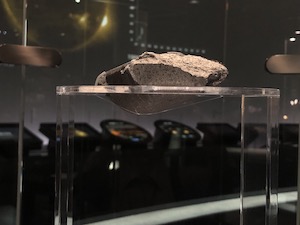Nagoya City Science Museum
TOP > Exhibition Guide > Floor Map> Komaki Meteorite
Komaki Meteorite



Purpose of Exhibition
On Wednesday, September 26, 2018, at around 22:30, in Komaki City, Aichi Prefecture, a meteorite fell to earth, hit the roof of a private house, bouncing up, and landed in front of another house. It was raining then, and they heard a loud noise in the area. Next morning, they found a breach in the roof of the former house(A), with black stony pieces (the second and third largest fragments of the meteorite) in the garden and terrace. They also noticed a hole penetrated in the carport of the latter house(B), and got a black stone (the largest fragment) at the entrance. A later investigation turned up other scratches on the beam of the carport and the car parked there.
This exhibit displays the actual meteorite, the largest fragment found at House B, and you can see it from all directions. We also show a polarized light microscopic movie of a petrographic thin section of the meteorite, the actual cut-out parts of the roof of House A (the first impact) and the carport of House B (the second impact), and a model of the meteorite trajectory.
Additional Knowledge
Meteorites are classified into iron meteorites, stony-iron meteorites and stone meteorites, based on their physical properties. The Komaki meteorite is a stone meteorite. Stone meteorites are further divided into achondrites and chondrites. Achondrites, meteorites without chondrules, are fragments of celestial bodies that once formed to some larger size. Chondrites, on the contrary, retain chondrules, that is, round grains dating back to 4.6 billion years ago when the Solar System was formed. The Komaki meteorite is categorized precisely as an L6 ordinary chondrite.
The analysis of argon in it reveals that the Komaki meteorite was formed 4.4 plus or minus 0.2 billion years ago (formation age), and the neon gas also indicates that its parent body, the original asteroid broke into small pieces 25.1 plus or minus 0.6 million years ago (cosmic-ray exposure age). As many Type-L chondrites share roughly the same 20 to 30 million year cosmic-ray exposure age, it is believed that they are derived from the same parent body, which was broken into numerous fragments by asteroid collisions, and some of which occasionally fall to Earth such as the Komaki meteorite.
This page was last edited on 30 June 2022.
http://www.ncsm.city.nagoya.jp/study/astro/komaki.html
https://www.kahaku.go.jp/research/db/science_engineering/inseki/inseki_list.html
